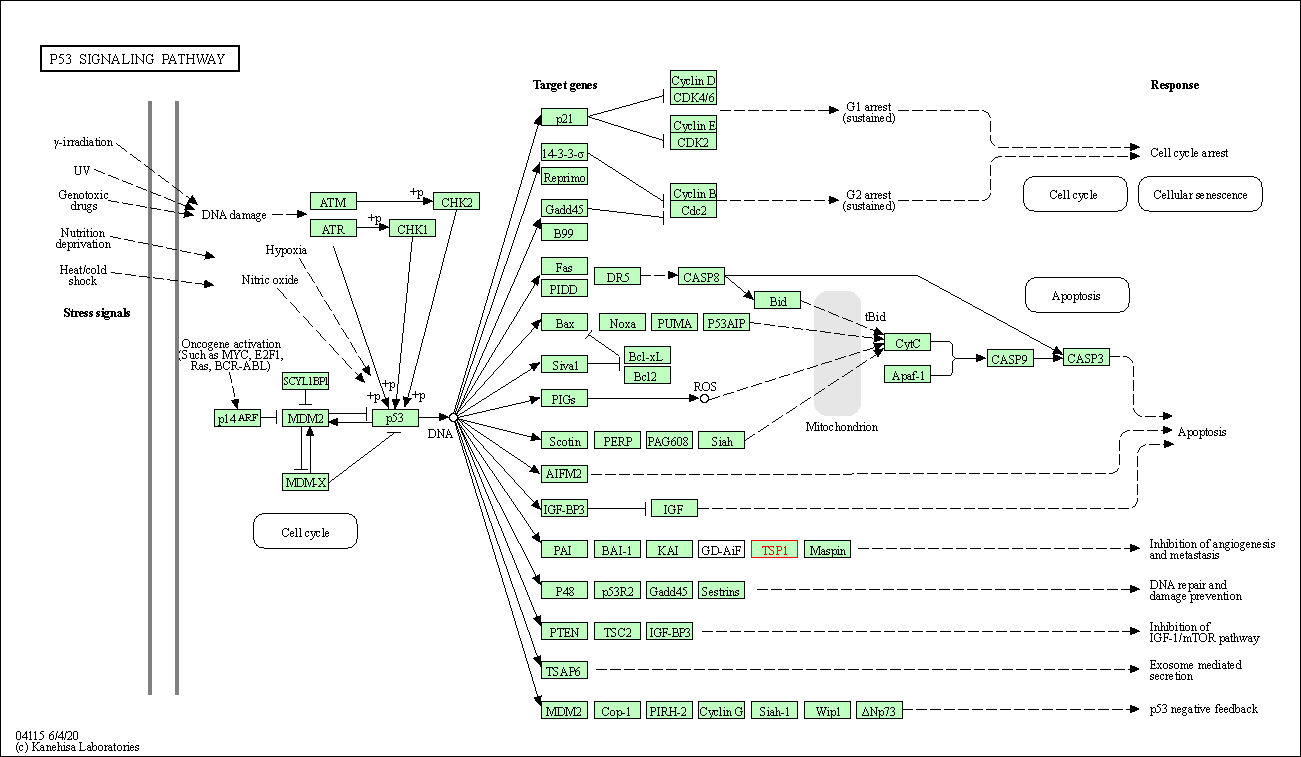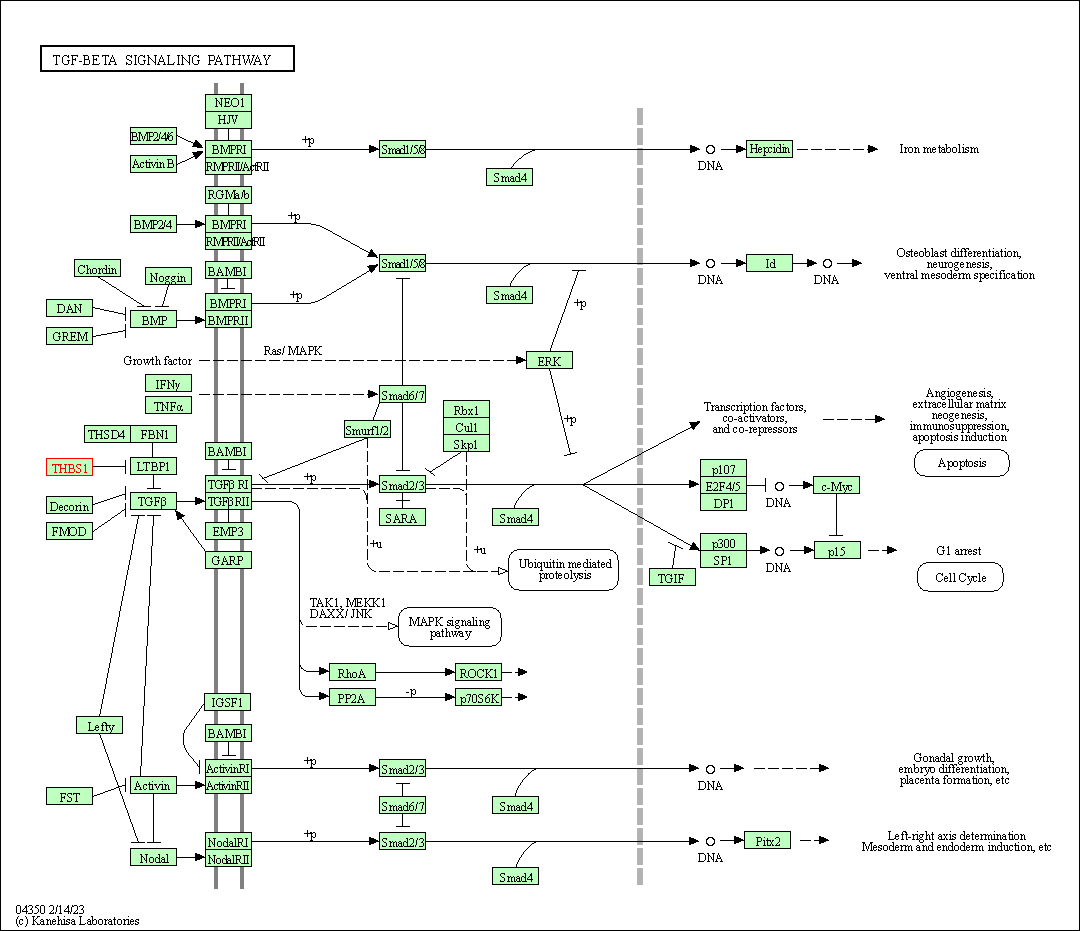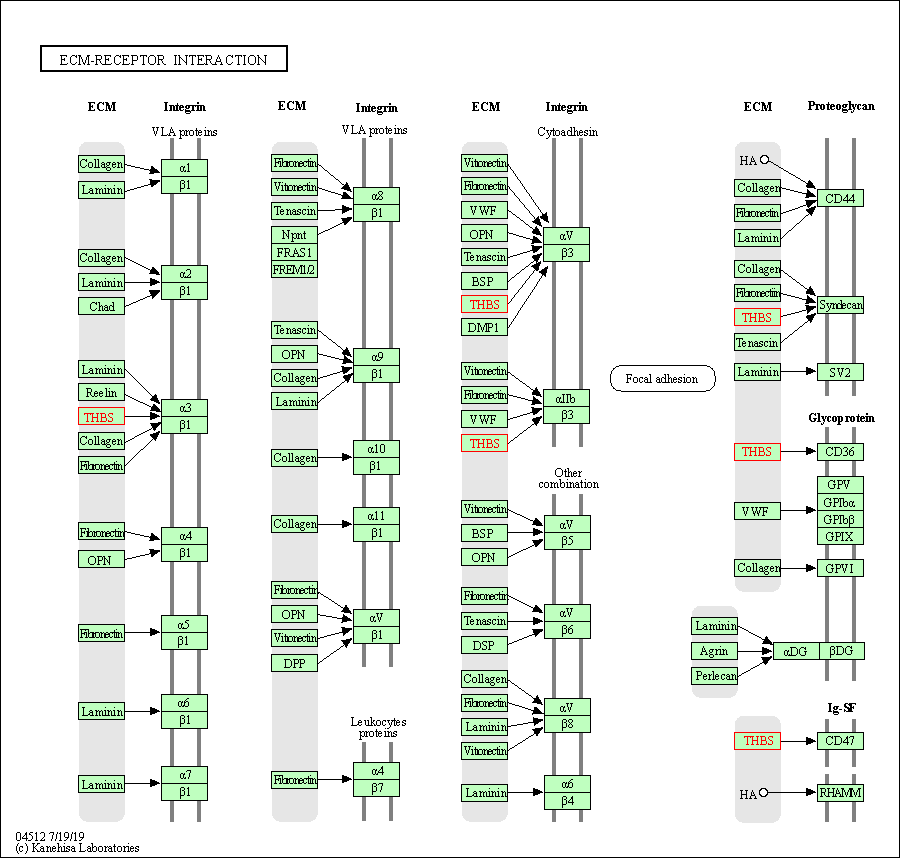Target Information
| Target General Information | Top | |||||
|---|---|---|---|---|---|---|
| Target ID |
T30784
(Former ID: TTDI02201)
|
|||||
| Target Name |
Thrombospondin-1 (THBS1)
|
|||||
| Synonyms |
TSP1; TSP; Glycoprotein G
Click to Show/Hide
|
|||||
| Gene Name |
THBS1
|
|||||
| Target Type |
Clinical trial target
|
[1] | ||||
| Disease | [+] 1 Target-related Diseases | + | ||||
| 1 | Solid tumour/cancer [ICD-11: 2A00-2F9Z] | |||||
| Function |
Binds heparin. May play a role in dentinogenesis and/or maintenance of dentin and dental pulp. Ligand for CD36 mediating antiangiogenic properties. Plays a role in ER stress response, via its interaction with the activating transcription factor 6 alpha (ATF6) which produces adaptive ER stress response factors. Adhesive glycoprotein that mediates cell-to-cell and cell-to-matrix interactions.
Click to Show/Hide
|
|||||
| UniProt ID | ||||||
| Sequence |
MGLAWGLGVLFLMHVCGTNRIPESGGDNSVFDIFELTGAARKGSGRRLVKGPDPSSPAFR
IEDANLIPPVPDDKFQDLVDAVRAEKGFLLLASLRQMKKTRGTLLALERKDHSGQVFSVV SNGKAGTLDLSLTVQGKQHVVSVEEALLATGQWKSITLFVQEDRAQLYIDCEKMENAELD VPIQSVFTRDLASIARLRIAKGGVNDNFQGVLQNVRFVFGTTPEDILRNKGCSSSTSVLL TLDNNVVNGSSPAIRTNYIGHKTKDLQAICGISCDELSSMVLELRGLRTIVTTLQDSIRK VTEENKELANELRRPPLCYHNGVQYRNNEEWTVDSCTECHCQNSVTICKKVSCPIMPCSN ATVPDGECCPRCWPSDSADDGWSPWSEWTSCSTSCGNGIQQRGRSCDSLNNRCEGSSVQT RTCHIQECDKRFKQDGGWSHWSPWSSCSVTCGDGVITRIRLCNSPSPQMNGKPCEGEARE TKACKKDACPINGGWGPWSPWDICSVTCGGGVQKRSRLCNNPTPQFGGKDCVGDVTENQI CNKQDCPIDGCLSNPCFAGVKCTSYPDGSWKCGACPPGYSGNGIQCTDVDECKEVPDACF NHNGEHRCENTDPGYNCLPCPPRFTGSQPFGQGVEHATANKQVCKPRNPCTDGTHDCNKN AKCNYLGHYSDPMYRCECKPGYAGNGIICGEDTDLDGWPNENLVCVANATYHCKKDNCPN LPNSGQEDYDKDGIGDACDDDDDNDKIPDDRDNCPFHYNPAQYDYDRDDVGDRCDNCPYN HNPDQADTDNNGEGDACAADIDGDGILNERDNCQYVYNVDQRDTDMDGVGDQCDNCPLEH NPDQLDSDSDRIGDTCDNNQDIDEDGHQNNLDNCPYVPNANQADHDKDGKGDACDHDDDN DGIPDDKDNCRLVPNPDQKDSDGDGRGDACKDDFDHDSVPDIDDICPENVDISETDFRRF QMIPLDPKGTSQNDPNWVVRHQGKELVQTVNCDPGLAVGYDEFNAVDFSGTFFINTERDD DYAGFVFGYQSSSRFYVVMWKQVTQSYWDTNPTRAQGYSGLSVKVVNSTTGPGEHLRNAL WHTGNTPGQVRTLWHDPRHIGWKDFTAYRWRLSHRPKTGFIRVVMYEGKKIMADSGPIYD KTYAGGRLGLFVFSQEMVFFSDLKYECRDP Click to Show/Hide
|
|||||
| 3D Structure | Click to Show 3D Structure of This Target | AlphaFold | ||||
| HIT2.0 ID | T00T9M | |||||
| Drugs and Modes of Action | Top | |||||
|---|---|---|---|---|---|---|
| Clinical Trial Drug(s) | [+] 2 Clinical Trial Drugs | + | ||||
| 1 | ABT-510 | Drug Info | Phase 2 | Solid tumour/cancer | [2] | |
| 2 | CVX-045 | Drug Info | Phase 2 | Solid tumour/cancer | [3] | |
| Mode of Action | [+] 2 Modes of Action | + | ||||
| Modulator | [+] 1 Modulator drugs | + | ||||
| 1 | ABT-510 | Drug Info | [4], [5] | |||
| Agonist | [+] 1 Agonist drugs | + | ||||
| 1 | CVX-045 | Drug Info | [1] | |||
| Cell-based Target Expression Variations | Top | |||||
|---|---|---|---|---|---|---|
| Cell-based Target Expression Variations | ||||||
| Drug Binding Sites of Target | Top | |||||
|---|---|---|---|---|---|---|
| Ligand Name: Beta-L-fucose | Ligand Info | |||||
| Structure Description | Crystal Structure of the Thrombospondin-1 Type 1 Repeats | PDB:1LSL | ||||
| Method | X-ray diffraction | Resolution | 1.90 Å | Mutation | No | [6] |
| PDB Sequence |
QDGGWSHWSP
425 WSSCSVTCGD435 GVITRIRLCN445 SPSPQMNGKP455 CEGEARETKA465 CKKDACPING 475 GWGPWSPWDI485 CSVTCGGGVQ495 KRSRLCNNPT505 PQFGGKDCVG515 DVTENQICNK 525 QDC
|
|||||
|
|
||||||
| Ligand Name: Selenomethionine | Ligand Info | |||||
| Structure Description | Crystal Structure of the Thrombospondin-1 N-terminal Domain in Complex with Arixtra | PDB:1ZA4 | ||||
| Method | X-ray diffraction | Resolution | 1.90 Å | Mutation | Yes | [7] |
| PDB Sequence |
SVFDIFELTG
20 AARKGSGRRL30 VKGPDPSSPA40 FRIEDANLIP50 PVPDDKFQDL60 VDAVRTEKGF 70 LLLASLRQKK81 TRGTLLALER91 KDHSGQVFSV101 VSNGKAGTLD111 LSLTVQGKQH 121 VVSVEEALLA131 TGQWKSITLF141 VQEDRAQLYI151 DCEKENAELD162 VPIQSVFTRD 172 LASIARLRIA182 KGGVNDNFQG192 VLQNVRFVFG202 TTPEDILRNK212 GCS |
|||||
|
|
||||||
| Click to View More Binding Site Information of This Target with Different Ligands | ||||||
| Different Human System Profiles of Target | Top |
|---|---|
|
Human Similarity Proteins
of target is determined by comparing the sequence similarity of all human proteins with the target based on BLAST. The similarity proteins for a target are defined as the proteins with E-value < 0.005 and outside the protein families of the target.
A target that has fewer human similarity proteins outside its family is commonly regarded to possess a greater capacity to avoid undesired interactions and thus increase the possibility of finding successful drugs
(Brief Bioinform, 21: 649-662, 2020).
Human Tissue Distribution
of target is determined from a proteomics study that quantified more than 12,000 genes across 32 normal human tissues. Tissue Specificity (TS) score was used to define the enrichment of target across tissues.
The distribution of targets among different tissues or organs need to be taken into consideration when assessing the target druggability, as it is generally accepted that the wider the target distribution, the greater the concern over potential adverse effects
(Nat Rev Drug Discov, 20: 64-81, 2021).
Human Pathway Affiliation
of target is determined by the life-essential pathways provided on KEGG database. The target-affiliated pathways were defined based on the following two criteria (a) the pathways of the studied target should be life-essential for both healthy individuals and patients, and (b) the studied target should occupy an upstream position in the pathways and therefore had the ability to regulate biological function.
Targets involved in a fewer pathways have greater likelihood to be successfully developed, while those associated with more human pathways increase the chance of undesirable interferences with other human processes
(Pharmacol Rev, 58: 259-279, 2006).
Biological Network Descriptors
of target is determined based on a human protein-protein interactions (PPI) network consisting of 9,309 proteins and 52,713 PPIs, which were with a high confidence score of ≥ 0.95 collected from STRING database.
The network properties of targets based on protein-protein interactions (PPIs) have been widely adopted for the assessment of target’s druggability. Proteins with high node degree tend to have a high impact on network function through multiple interactions, while proteins with high betweenness centrality are regarded to be central for communication in interaction networks and regulate the flow of signaling information
(Front Pharmacol, 9, 1245, 2018;
Curr Opin Struct Biol. 44:134-142, 2017).
Human Similarity Proteins
Human Tissue Distribution
Human Pathway Affiliation
Biological Network Descriptors
|
|
|
Note:
If a protein has TS (tissue specficity) scores at least in one tissue >= 2.5, this protein is called tissue-enriched (including tissue-enriched-but-not-specific and tissue-specific). In the plots, the vertical lines are at thresholds 2.5 and 4.
|
| KEGG Pathway | Pathway ID | Affiliated Target | Pathway Map |
|---|---|---|---|
| Rap1 signaling pathway | hsa04015 | Affiliated Target |

|
| Class: Environmental Information Processing => Signal transduction | Pathway Hierarchy | ||
| p53 signaling pathway | hsa04115 | Affiliated Target |

|
| Class: Cellular Processes => Cell growth and death | Pathway Hierarchy | ||
| Phagosome | hsa04145 | Affiliated Target |

|
| Class: Cellular Processes => Transport and catabolism | Pathway Hierarchy | ||
| PI3K-Akt signaling pathway | hsa04151 | Affiliated Target |

|
| Class: Environmental Information Processing => Signal transduction | Pathway Hierarchy | ||
| TGF-beta signaling pathway | hsa04350 | Affiliated Target |

|
| Class: Environmental Information Processing => Signal transduction | Pathway Hierarchy | ||
| Focal adhesion | hsa04510 | Affiliated Target |

|
| Class: Cellular Processes => Cellular community - eukaryotes | Pathway Hierarchy | ||
| ECM-receptor interaction | hsa04512 | Affiliated Target |

|
| Class: Environmental Information Processing => Signaling molecules and interaction | Pathway Hierarchy | ||
| Click to Show/Hide the Information of Affiliated Human Pathways | |||
| Degree | 14 | Degree centrality | 1.50E-03 | Betweenness centrality | 6.36E-04 |
|---|---|---|---|---|---|
| Closeness centrality | 2.22E-01 | Radiality | 1.39E+01 | Clustering coefficient | 8.79E-02 |
| Neighborhood connectivity | 2.61E+01 | Topological coefficient | 1.11E-01 | Eccentricity | 11 |
| Download | Click to Download the Full PPI Network of This Target | ||||
| Target Regulators | Top | |||||
|---|---|---|---|---|---|---|
| Target-regulating microRNAs | ||||||
| References | Top | |||||
|---|---|---|---|---|---|---|
| REF 1 | Antitumor efficacy of a thrombospondin 1 mimetic CovX-body. Transl Oncol. 2011 Aug;4(4):249-57. | |||||
| REF 2 | ClinicalTrials.gov (NCT00602199) ABT-510 in Treating Patients With Metastatic Melanoma. U.S. National Institutes of Health. | |||||
| REF 3 | ClinicalTrials.gov (NCT00061659) Study Evaluating the Safety and Efficacy of ABT-510 in Subjects With Locally Advanced or Metastatic Soft Tissue Sarcoma. U.S. National Institutes of Health. | |||||
| REF 4 | A phase II study of ABT-510 (thrombospondin-1 analog) for the treatment of metastatic melanoma. Am J Clin Oncol. 2007 Jun;30(3):303-9. | |||||
| REF 5 | The thrombospondin-1 mimetic ABT-510 increases the uptake and effectiveness of cisplatin and paclitaxel in a mouse model of epithelial ovarian cancer. Neoplasia. 2010 Mar;12(3):275-83. | |||||
| REF 6 | Crystal structure of the TSP-1 type 1 repeats: a novel layered fold and its biological implication. J Cell Biol. 2002 Oct 28;159(2):373-82. | |||||
| REF 7 | The structures of the thrombospondin-1 N-terminal domain and its complex with a synthetic pentameric heparin. Structure. 2006 Jan;14(1):33-42. | |||||
If You Find Any Error in Data or Bug in Web Service, Please Kindly Report It to Dr. Zhou and Dr. Zhang.

